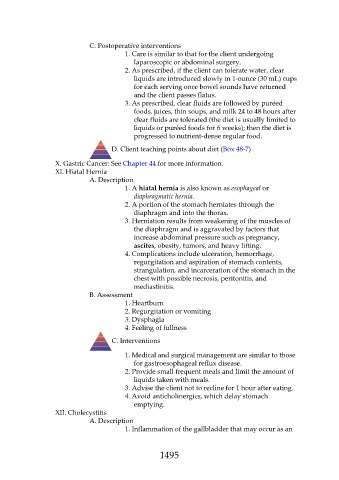Page 1495 - Saunders Comprehensive Review For NCLEX-RN
P. 1495
C. Postoperative interventions
1. Care is similar to that for the client undergoing
laparoscopic or abdominal surgery.
2. As prescribed, if the client can tolerate water, clear
liquids are introduced slowly in 1-ounce (30 mL) cups
for each serving once bowel sounds have returned
and the client passes flatus.
3. As prescribed, clear fluids are followed by puréed
foods, juices, thin soups, and milk 24 to 48 hours after
clear fluids are tolerated (the diet is usually limited to
liquids or puréed foods for 6 weeks); then the diet is
progressed to nutrient-dense regular food.
D. Client teaching points about diet (Box 48-7)
X. Gastric Cancer: See Chapter 44 for more information.
XI. Hiatal Hernia
A. Description
1. A hiatal hernia is also known as esophageal or
diaphragmatic hernia.
2. A portion of the stomach herniates through the
diaphragm and into the thorax.
3. Herniation results from weakening of the muscles of
the diaphragm and is aggravated by factors that
increase abdominal pressure such as pregnancy,
ascites, obesity, tumors, and heavy lifting.
4. Complications include ulceration, hemorrhage,
regurgitation and aspiration of stomach contents,
strangulation, and incarceration of the stomach in the
chest with possible necrosis, peritonitis, and
mediastinitis.
B. Assessment
1. Heartburn
2. Regurgitation or vomiting
3. Dysphagia
4. Feeling of fullness
C. Interventions
1. Medical and surgical management are similar to those
for gastroesophageal reflux disease.
2. Provide small frequent meals and limit the amount of
liquids taken with meals.
3. Advise the client not to recline for 1 hour after eating.
4. Avoid anticholinergics, which delay stomach
emptying.
XII. Cholecystitis
A. Description
1. Inflammation of the gallbladder that may occur as an
1495

